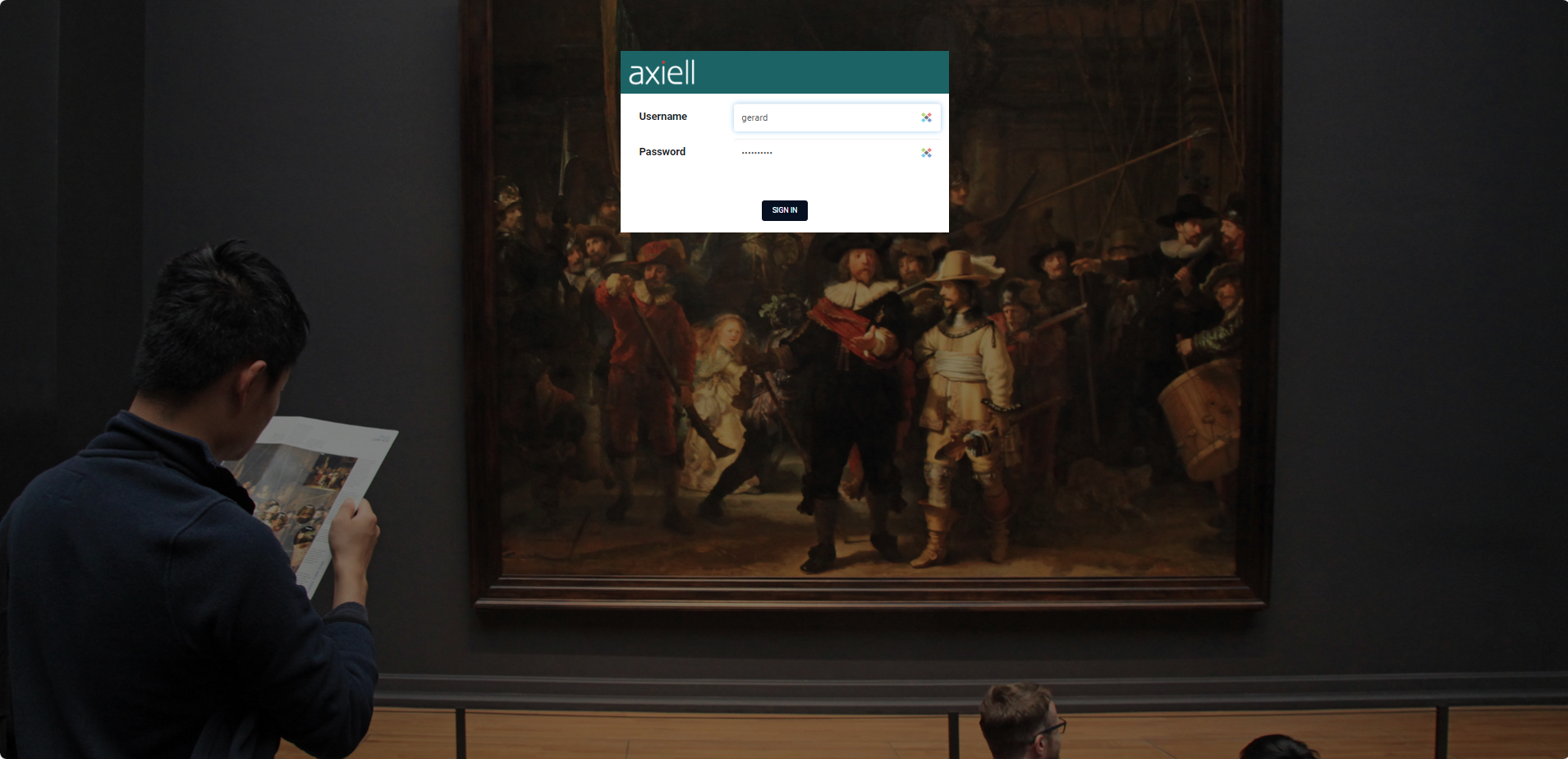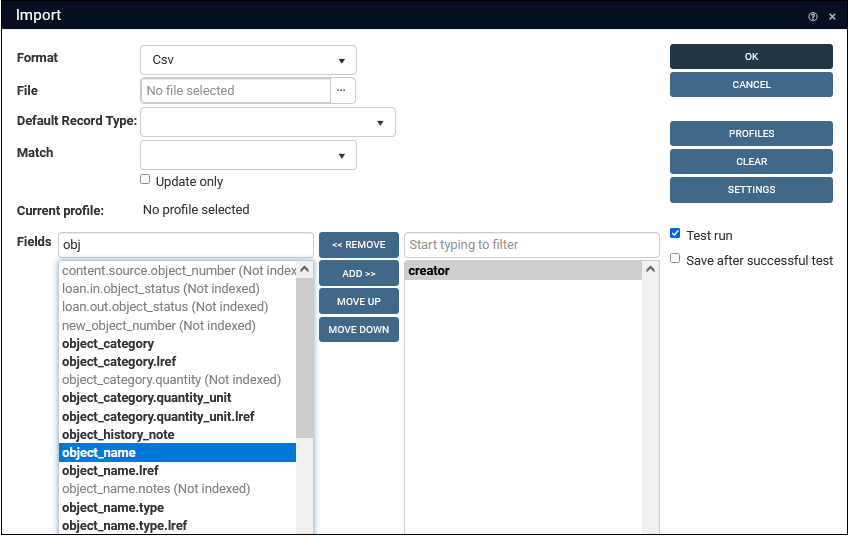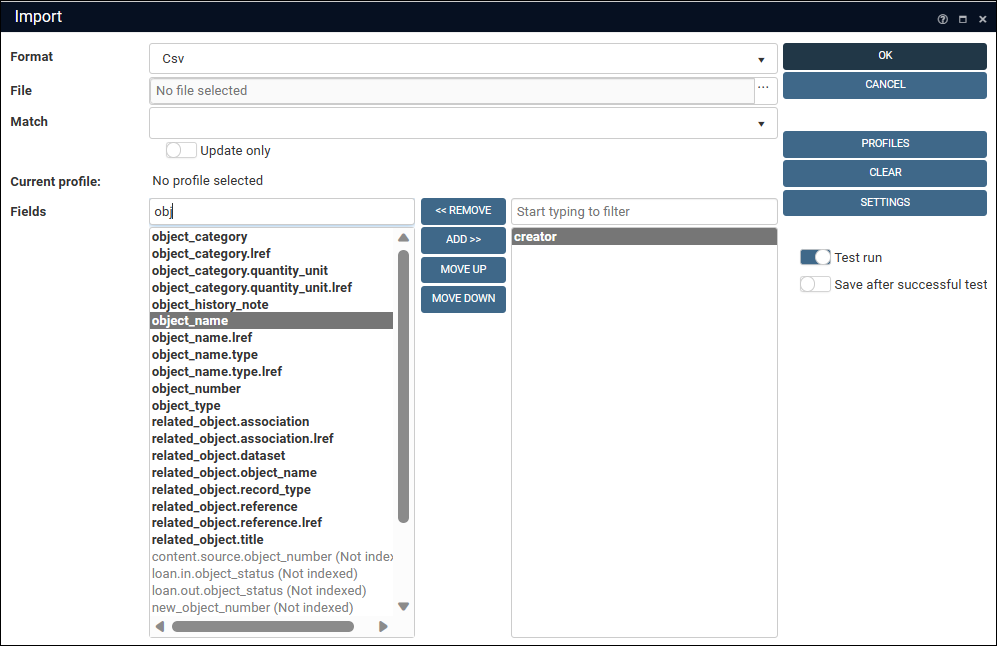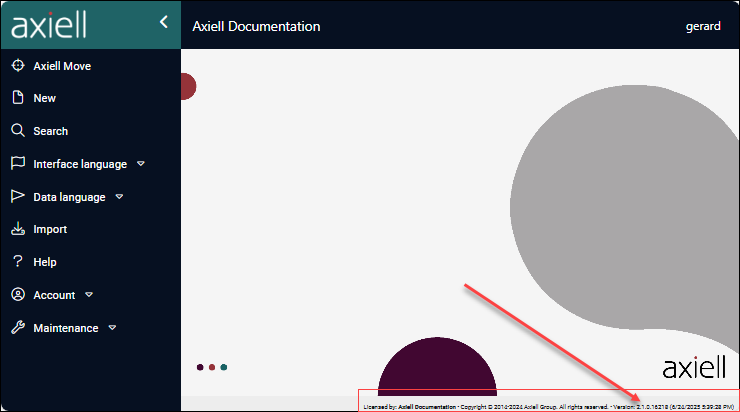FAQ
Axiell Collections is an HTML5 web-based Collections Management System (CMS) that runs in any modern browser, notably Mozilla Firefox, Microsoft Edge, Google Chrome and Apple Safari. No browser plug-ins are required.
It is highly recommended that you use the latest version of your preferred browser and keep it up to date.
When a checkbox is not selected (it is empty and does not contain a tick), its value is NULL. When a checkbox is ticked, the value it holds is x.
Here we see the Publish on web (publish_on_web (wp)) field on the Management details panel:

Unticked
To search for records in which a checkbox is unticked, we perform the following Advanced search:
<tag_or_field_name> = ""
For example, to return records where the Publish on web checkbox is unticked:
publish_on_web = ""
-OR-
wp = ""
NOTE: this method only works if the field is indexed; if the field is not indexed, it is only possible to return records where the checkbox is unticked with:
all and not <tag_or_field_name> = *
e.g.:
all and not wp = *
Tip: A simple way to identify whether a field is indexed or not is to view the Fields list in the Advanced search panel: the names of non-indexed fields are faded (grey), they are listed after indexed fields (which are bold) and clearly labelled as Not indexed.
Ticked
To search for records in which a checkbox is ticked, we perform the following Advanced search:
<tag_or_field_name> = x
-OR-
<tag_or_field_name> = *
(this wildcard will return all records in which the field contains a value).
For example, to return records where the Publish on web checkbox is ticked:
wp = x
Knowing that the value in a ticked checkbox is an x is important when performing a search and replace on a checkbox or when adding a tick to a checkbox when importing data.
See How do I search for a ticked /unticked checkbox? for details about how to return records where a checkbox is ticked or unticked.
In summary, when a checkbox is not selected (it is empty and does not contain a tick), its value is NULL. When a checkbox is ticked, the value it holds is x.
If all we need to do is return records where a checkbox is ticked, we could perform the following Advanced wildcard search:
publish_on_web = *
(return all records in which the Publish on web field contains a value).
But how do we perform a search and replace on a checkbox or add a tick to a checkbox when importing data? The answer is x: when a checkbox is selected, the value stored in the field is an x.
Note: A search for publish_on_web = x will also return all records where the Publish on web checkbox is ticked.
To search for records where the Publish on web checkbox is ticked and remove the tick, we search for x and replace it with nothing:

Do the opposite to add a tick to a checkbox (search for nothing and replace it with an x).
If we want to import records in which the Publish on web checkbox is ticked, the value we import into the field is an x.
How do I identify a field's data type?
How do I restore a changed value in a field?
There is no native field for this data, where can I put it?
What are Free fields and what do I use them for?
What happens when an inherited occurrence is edited?
What is the difference between a field's label and its system name?
What is a Merged-in (merge) field?
How do I save a set of records as a group?
How do I retrieve a group of records?
Check whether a filter is active; a filter is essentially a persistent search statement that is automatically added to every search query until you disable it. When a filter is active when you restore a group, any records in the group that meet the filter's search criteria will be filtered out and will not be restored.
If there is a filter icon beside the name of the current data source in the Title bar, a filter is active:
Full details about filters and how to deactivate them can be found here.
Details about indexing in Collections, including Full text indexing can be found here.
If your organization's Axiell Collections licence has expired, you will receive a message similar to the following when trying to log in (after which login fails):
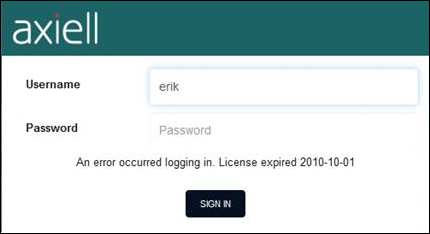
Contact Support for assistance.
If all licences available to your organization are currently being used, you will receive a message similar to the following when attempting to log in (after which login fails):
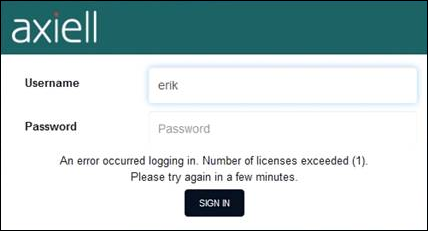
A licence will become available immediately when at least one user logs out of Collections by selecting Account>Log out from the Main menu; if a user does not log out correctly and simply closes the browser or tab in which they were working, their licence will be released after 5 minutes (from version 1.9.6 onwards) or when an Administrator manually releases it.
Note: In a Hosted environment it is important to log out of Collections (select Account>Log out from the Main menu) rather than simply close the browser tab or browser in which you are working so that your licence is immediately freed-up for another user.
Note that Collections counts licences in use per browser, so if a user has a session open in two browsers, this will use two licences.
The background image of the Collections Login screen changes every 30 seconds:
A default set of images is used, and these are stored in the \Content\Backgrounds\Login sub folder of the Collections core software installation, e.g.:
Users with Administrative access are able to delete these images and copy other images to this folder.
Images are automatically resized to fit a screen, so a large resolution for the image files is recommended (at least 1920 x 1080). When the image files are replaced it is only necessary to refresh your browser (F5) to view the new images (they will display automatically next time a user accesses your Collections site).
Important
Every time the Collections core software is updated to a new version, the default images will be copied to this folder again, alongside your own images and you will need to delete them.
When you are logged in to a Collections application it is possible1 to open it in multiple tabs in a browser; this allows you to work on different things in Collections at the same time (e.g. searching on one tab, adding a new record in another, viewing different records on different tabs, and so on). Logging out logs you out of all instances of Collections in tabs in the current browser, and in any other instances of the browser if it was opened as another window.
Note however: if your institution has more than one Collections application installed on the same server (e.g. Production and Training) and you are logged in to one and then log in to another on a different tab in the same browser, you will be logged out of the first.
This occurs when more than one Collections application is installed on the same server and in the same domain (the domain is bold in these examples), e.g.:
https://supp-srv-01.adlibsoft.com/production
and
https://supp-srv-01.adlibsoft.com/training
The explanation for this behaviour is that ASP.Net sessions are shared among browser tabs on a domain basis; as a result, a new application session is created when you log in to a different instance of the Collections application and any open session in another tab is automatically lost.
The solution is either to have a separate domain for each instance of the Collections application or, more simply, to use a separate browser for each Collections application.
What is the Collections Model Application?
Axiell Collections comprises two main components: the Axiell Collections Software and a Model Application.
A useful way to understand the relationship between the Axiell Collections Software and the Model Application is to think of the Axiell Collections Software as a container (the User Interface) into which we slot one configuration of the Model Application or another. All implementations of Axiell Collections essentially run the same core , but each institution will slot in a configuration of the Model Application that supports its type of collection.
More details here.
The easiest way to identify which version of the Model Application is running in your Axiell Collections system is to check the browser tab in which Axiell Collections is running. In this example, Model Application version 5.0 is used by Axiell Collections:

Details in the browser tab are specified in Axiell Designer![]() A tool for designing, creating, customizing and managing Axiell Collections applications and databases, broadly speaking, the Axiell Collections Model Application. As well as managing databases, including user access and permissions, Designer is used for such tasks as translating field labels, tooltips, values in drop lists, etc. on the Application Files tab of an Application definition
A tool for designing, creating, customizing and managing Axiell Collections applications and databases, broadly speaking, the Axiell Collections Model Application. As well as managing databases, including user access and permissions, Designer is used for such tasks as translating field labels, tooltips, values in drop lists, etc. on the Application Files tab of an Application definition .pbk file (details here): amongst other things, an Application definition file registers which data sources are accessible in a Collections application, and which access points (essentially fields to query), screens and output formats are available.
Details about the Model Application and release notes for each version can be found here.
To present record data in a single table, using a Word template as the Output format![]() An Output format is an XSLT style sheet or Microsoft Word or Excel template that specifies what fields are included in a report or printed output, and how the data is laid out and styled., all field references are specified in a single row and the <<[StartRecordList]>> / <<[EndRecordList]>> parameters are included in the rows above and below the field references row. In this example, we add column headers in the top row (this is optional); the title(s), author(s) and document type from records in the Library catalogue will be listed in a table:
An Output format is an XSLT style sheet or Microsoft Word or Excel template that specifies what fields are included in a report or printed output, and how the data is laid out and styled., all field references are specified in a single row and the <<[StartRecordList]>> / <<[EndRecordList]>> parameters are included in the rows above and below the field references row. In this example, we add column headers in the top row (this is optional); the title(s), author(s) and document type from records in the Library catalogue will be listed in a table:
|
Title |
Author |
Document type |
|---|---|---|
|
<<[StartRecordList]>> |
|
|
|
<<TI>> |
<<ya>> |
<<df>> |
|
<<[EndRecordList]>> |
|
|
It is possible to present the data for each record in its own table however, and this will accommodate a more complex presentation of the data across multiple rows and columns. To achieve this, do not include the <<[StartRecordList]>> / <<[EndRecordList]>> parameters.
In this case, it is important that Text wrapping is set to None in the Table properties dialogue: select Properties on the Layout tab of the Ribbon and confirm that Text wrapping is set to None (it should be by default). If Text wrapping is not set to None and a fixed position has been specified for your table, you will find that tables will display on top of each other when your record data is printed.
More details about using tables in Word templates can be found here.
Can I restore a deleted record? (Yes, in certain circumstances)
A record's unique identifier is its priref, a number allocated when a record is created. Currently, the simplest way to view a record's unique identifier is to add the priref column to Result set View.
Although no third-party report generator is required to build reports in Collections, if your reporting needs are not met by Collections' in-built reporting facility, integration with powerful reporting tools like MS Power BI is supported by the Collections WebAPI. Application Administrators can find details about the Collections WebAPI here (or contact Support for details).
Details about reporting in Collections can be found here.
To present record data in a single table, using a Word template as the Output format![]() An Output format is an XSLT style sheet or Microsoft Word or Excel template that specifies what fields are included in a report or printed output, and how the data is laid out and styled., all field references are specified in a single row and the <<[StartRecordList]>> / <<[EndRecordList]>> parameters are included in the rows above and below the field references row. In this example, we add column headers in the top row (this is optional); the title(s), author(s) and document type from records in the Library catalogue will be listed in a table:
An Output format is an XSLT style sheet or Microsoft Word or Excel template that specifies what fields are included in a report or printed output, and how the data is laid out and styled., all field references are specified in a single row and the <<[StartRecordList]>> / <<[EndRecordList]>> parameters are included in the rows above and below the field references row. In this example, we add column headers in the top row (this is optional); the title(s), author(s) and document type from records in the Library catalogue will be listed in a table:
|
Title |
Author |
Document type |
|---|---|---|
|
<<[StartRecordList]>> |
|
|
|
<<TI>> |
<<ya>> |
<<df>> |
|
<<[EndRecordList]>> |
|
|
It is possible to present the data for each record in its own table however, and this will accommodate a more complex presentation of the data across multiple rows and columns. To achieve this, do not include the <<[StartRecordList]>> / <<[EndRecordList]>> parameters.
In this case, it is important that Text wrapping is set to None in the Table properties dialogue: select Properties on the Layout tab of the Ribbon and confirm that Text wrapping is set to None (it should be by default). If Text wrapping is not set to None and a fixed position has been specified for your table, you will find that tables will display on top of each other when your record data is printed.
More details about using tables in Word templates can be found here.
How do I perform a Standard search?
How do I construct an Advanced search statement?
When specifying a search value that includes a space, hyphen (-) or plus (+), it is necessary to place quotes around the entire search value. This includes dates, e.g.: "2020-10-06". Single or double quotes can be used; in this documentation we use double quotes.
IMPORTANT: Be sure to use straight quotes (" or ') not smart (typographer's) quotes (“ and ”).
More details here.
How do I save my search statement and rerun it?
How do I search for a tick in a checkbox?
How do I search for an inherited value?
Why is my Advanced search slow?
Can I limit all my searches to a subset of records?
There are several reasons why a search might not return all the records you might expect to see. It is possible that your search terms are excluding records (adjust your search terms); or that you are not authorized to see all records (speak to your Application Administrator); or perhaps there is an active filter that is filtering out records. A filter is essentially a persistent search statement that is automatically added to every search query until you disable it.
If there is a filter icon beside the name of the current data source in the Title bar, a filter is active:
Full details about filters and how to deactivate them can be found here.
The following only affects data sources without Full text indexing.
Some background (this is explained in more detail here): not all fields in Collections are indexed. When you search a data source![]() The management of a collection can involve a vast amount of information about objects / items / books, people and organizations, events, administration and more. This information is stored as records in data sources. Each data source stores a specific type of information: details about collection items, people, events, loans, and so on. using the Standard tab of the Search box, only indexed fields are made available for searching. For our purposes, a field can be indexed in one of two ways: the entire contents of the field is indexed as a single value, a Text (term) index, or each word in a field is indexed separately, a Free text index.
The management of a collection can involve a vast amount of information about objects / items / books, people and organizations, events, administration and more. This information is stored as records in data sources. Each data source stores a specific type of information: details about collection items, people, events, loans, and so on. using the Standard tab of the Search box, only indexed fields are made available for searching. For our purposes, a field can be indexed in one of two ways: the entire contents of the field is indexed as a single value, a Text (term) index, or each word in a field is indexed separately, a Free text index.
The issue: from Collections 1.16 onwards, the search operator drop list in a Standard search includes the contains all, contains any and contains phrase search operators; at the moment however, when searching fields with a Free text index, contains any and contains phrase behave as contains all, locating the search value anywhere in the search field (it is worth mentioning that contains phrase has in fact always performed a contains all search in Free text indexed fields).
This will be changed in a future release.
An optional (paid) add-on integration with Microsoft SharePoint is available from Collections 3.0 onwards. If your organization uses SharePoint, it is possible to configure one or more application fields to store uploaded files (or documents generated by ADAPL) directly in SharePoint instead of on a network drive. When a file is uploaded, Collections creates a link to the file in SharePoint. If the document is editable (Word documents for instance), clicking the link or the Download icon will open it in SharePoint; otherwise the document will open (read-only) in the browser if the browser can display it (PDFs for instance).
For users, the application field and file name will look and function as usual, the only difference is the storage location. Because files are stored in SharePoint, they can also be accessed directly through SharePoint in your browser.
Be aware that uploading a large file to SharePoint will increase the time it takes to save the record. There is no synchronization between the two systems for deleting files or file links, and Collections cannot remove files uploaded to SharePoint; you should not delete files directly in SharePoint without also removing their corresponding links in Collections.
A prerequisite is that your Collections application uses Single Sign-On authentication through Microsoft Azure via the cloud.
Contact Axiell Support for details about integration with Microsoft SharePoint.
How do I sort items (rows) in a table?
We demonstrate how to filter items (rows) in a table using Result set View; the method is similar in other tables.
It is possible to filter records on the values in one or more columns so that only records that match the filtering condition are listed.
To filter records based on the values in a column:
- Click the three vertically aligned dots in a column header (title in this example) and select Filter from the menu:
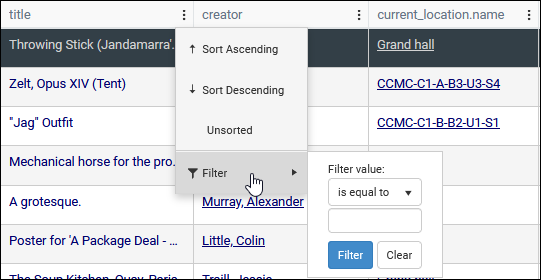
- Depending on the field type you will be able to:
- Select a value from a drop list:
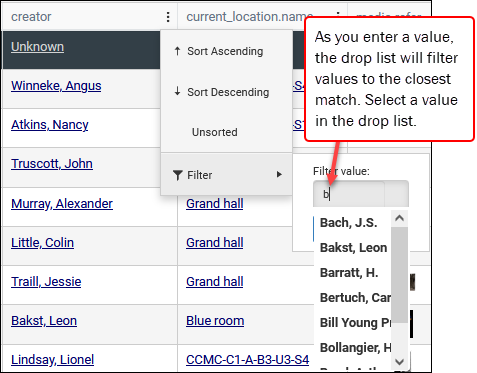
-OR-
- Select an operator from the drop list:
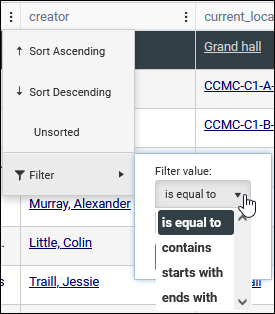
Operator
Details
is equal to
All records that do not match the filter value are filtered out.
contains
All records that do not match contain the filter value are filtered out.
starts with
All records that do not start with the specified character(s) are filtered out.
ends with
All records that do not end with the specified character(s) are filtered out.
Note: The filter ignores case and diacritics (accents etc.)
- And then enter a value in the text box:
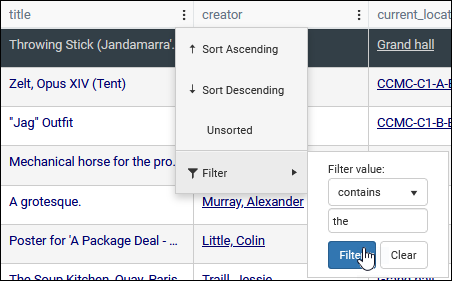
- Select a value from a drop list:
- Depending on the field type you will be able to:
- Select Filter.
All records that do not meet the condition set by the operator and value are filtered out. In this example, only records where the value contains the anywhere in the title field are listed:
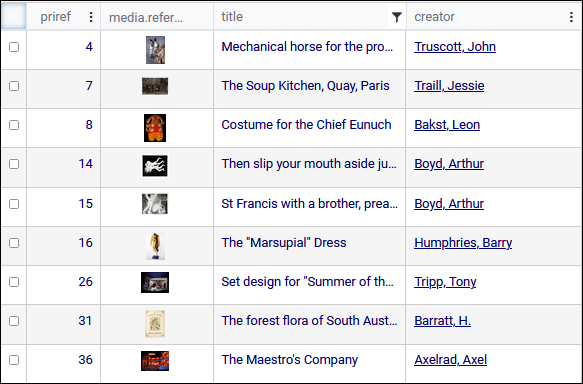
Note the filter
 icon in the column header indicating that a filter has been specified on this column.
icon in the column header indicating that a filter has been specified on this column. - To further filter the records listed, we could modify the filter on the title column or add another filter on one of the other columns.
Note: If you need to filter records by values in a field that is not included in the Result set View, it is possible to add (and remove) columns in the Result set settings box, which is accessed by selecting Settings in the Result set View toolbar.
- To remove the filter, select Clear.
A simple way to change the order of columns temporarily in any table in Collections is to:
- Click anywhere in a column header and hold down the mouse button.
- Drag left or right and release the mouse button.
This is not a permanent change to the order of columns.
For a permanent change to the order of columns in Result set View, select Settings in the Result set View toolbar:

Details here.
Field groups can be configured to display as table grids. In versions of Collections prior to version 1.11, grids have a fixed height with a vertical scrollbar to scroll through all the rows. With Collections 1.11 onwards it is possible to change the height of table grids, to show more or fewer rows by default for instance.
In Display mode, hover the cursor over the corner icon (six small dots in a triangle) in the bottom right corner of the grid until it changes to a double arrow:
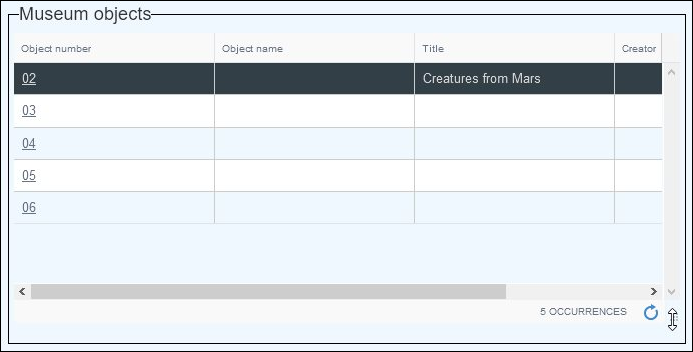
Hold the left mouse button down and drag the icon up or down to change the height of the grid; let go of the mouse button to fix the height. The new height of this box is remembered for you by Collections:

The background image of the Collections Login screen changes every 30 seconds:
A default set of images is used, and these are stored in the \Content\Backgrounds\Login sub folder of the Collections core software installation, e.g.:
Users with Administrative access are able to delete these images and copy other images to this folder.
Images are automatically resized to fit a screen, so a large resolution for the image files is recommended (at least 1920 x 1080). When the image files are replaced it is only necessary to refresh your browser (F5) to view the new images (they will display automatically next time a user accesses your Collections site).
Important
Every time the Collections core software is updated to a new version, the default images will be copied to this folder again, alongside your own images and you will need to delete them.
A number of Views include a Reset option that will restore the default settings of the View without affecting every other settings across Collections:
Many dialogue boxes also include a Reset option that will restore the dialogue to its default settings.
To reset all settings across Collections, use the Account>Settings option in the Main menu.
Why does the value in a field have a dotted underline?
Why is the value in a field faded (a lighter grey)?
Depending on your version of Collections, you will find options in some dialogue boxes controlled by a checkbox (older versions of Collections) or a slider (Collections version 1.17 onwards). For example, here we see the older style Import dialogue:
and here the new:
The functionality is identical. Enable a checkbox by clicking it so that it has a tick; enable a slider by sliding it so that it has a blue background.
Note: You may also find that some screen captures in the Help still show a checkbox when Collections now has a slider. Over time, all affected screens will be updated to show a slider.
In Collections 3.0 onwards, the software version, build number and build date of your Collections implementation is found in the Information box by selecting Account>Information from the Main menu:
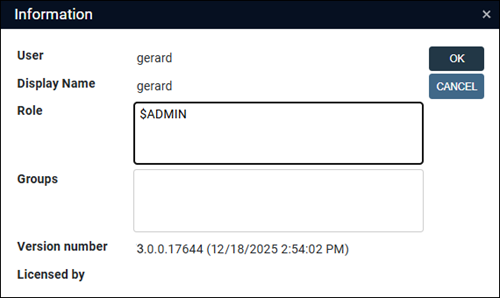
In older versions of Collections this information is located in the Status bar of the Collections browser window:
Tip: The font size is fairly small and it can be easier to read the details by copying the text and pasting it into a document.
The easiest way to identify which version of the Model Application is running in your Axiell Collections system is to check the browser tab in which Axiell Collections is running. In this example, Model Application version 5.0 is used by Axiell Collections:

Details in the browser tab are specified in Axiell Designer![]() A tool for designing, creating, customizing and managing Axiell Collections applications and databases, broadly speaking, the Axiell Collections Model Application. As well as managing databases, including user access and permissions, Designer is used for such tasks as translating field labels, tooltips, values in drop lists, etc. on the Application Files tab of an Application definition
A tool for designing, creating, customizing and managing Axiell Collections applications and databases, broadly speaking, the Axiell Collections Model Application. As well as managing databases, including user access and permissions, Designer is used for such tasks as translating field labels, tooltips, values in drop lists, etc. on the Application Files tab of an Application definition .pbk file (details here): amongst other things, an Application definition file registers which data sources are accessible in a Collections application, and which access points (essentially fields to query), screens and output formats are available.
More details about the Model Application can be found here.
